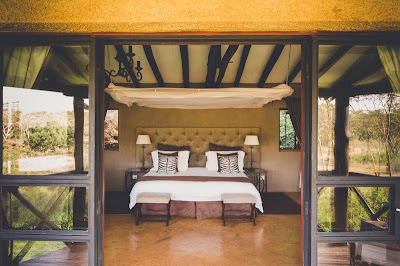A long way from the familiar National Parks and Reserves, in Kenya’s remote Northern Frontier lies Sarara, a small, intimate tented camp surrounded by wilderness. The only accommodation for miles around, this is truly wild and immersive. It also happens to have style, luxury, amazing food and exemplary eco credentials.
Wild and free
Being off the beaten track has its benefits. While the major wildlife regions such as the Masai Mara and Amboseli offer the must-see thrills of abundant game viewing in classic safari country, delving deeper into the more mysterious northern parts of Kenya reveals a whole other aspect to Africa and one which many guests find intensely rewarding.
 |
| Sarara's infinity pool and the mountain view beyond |
One obvious benefit of a location like this is experiencing the space and beauty of Africa with relatively few other people around. The quietness brings out the timeless quality of Africa’s wilderness and can be powerfully moving.
Another great advantage of Sarara’s particular location on the Namunyak Range in Laikipia, is that despite having less wildlife than the big safari regions, it’s brilliant for spotting some of Africa’s more unusual and elusive species. Guests at Sarara often enjoy sightings of leopards, African wild dogs, lesser kudus and aardwolves, to name but a few. And unlike in the big parks, there’s the distinct bonus of being allowed to wander on foot in bush walks.
The wildlife is far from being the only spectacle to take in here. The dramatically pointed mountains of Mathews Range make a stunning focal point, and rugged bushland unfold all around.
Comfort and charm
With such beautiful surroundings, the Sarara camp has a lot to live up to – and obligingly, it delivers in abundance. Comfortingly rustic camping charm combines with chic touches, high-ceilinged tents and great personal facilities (basics like running water, electric lighting and indoor flushing toilets become assets that you can suddenly appreciate in a place so remote).
 |
| Rustic luxury - one of Sarara's bedroom tents |
A real treat is a natural rock infinity pool with in which you can gaze out at the splendour of the mountain range beyond. The pool also overlooks the nearby watering hole, so while you lounge in the water, you might be entertained by elephants or kudus as they drop off daily for a drink.
An eco dream
Sarara’s thoughtful regard to its relationship with the environment and local community add yet further points to its sizeable list of merits. Much of its food is grown organically on-site. Its water is supplied by is a gravity-fed system from the mountains. Building materials have been locally sourced with minimal impact.
But the wider picture is the success of the community conservation project in which Sarara Camp plays an important part. Working together with the local Samburu community, the Namunyak Wildlife Conservation Trust has transformed this region, helping to protect wildlife and halt the elephant poaching which had previously been rife here. Sustainable tourism practised by the likes of Sarara has been crucial in incentivising this environmental protection.
Sarara offers pure eco luxury and is a testament to how good tourism can be when it’s small-scale, high-quality and delivered with passion and conviction. We’d happily stay there time and time again. And if this fits with your own dream of Africa, we’d love to take you there too.



















